
The Ardhanarishvara, is a form of the Hindu deity Shiva combined with his consort Parvati. Ardhanarishvara is depicted as half-male and half-female, equally split down the middle. The right half is usually the male Shiva, illustrating his traditional attributes.
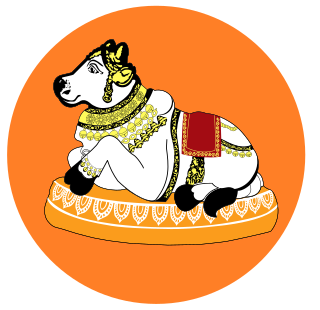
Bhairava, or Kala Bhairava, is a Shaivite and Vajrayāna deity worshiped by Hindus and Buddhists. In Shaivism, he is a powerful manifestation, or avatar, of Shiva associated with annihilation. In Trika system Bhairava represents Supreme Reality, synonymous to Para Brahman. Generally in Hinduism, Bhairava is also called Dandapani, as he holds a rod or Danda to punish sinners, and Svaśva, meaning "whose vehicle is a dog". In Vajrayana Buddhism, he is considered a fierce emanation of boddhisatva Mañjuśrī, and also called Heruka, Vajrabhairava, and Yamantaka.
Matrikas (Sanskrit: मातृका (singular), IAST: mātṝkās, lit. "divine mothers") also called Matar or Matri, are a group of mother goddesses who are always depicted together in Hinduism. The Matrikas are often depicted in a group of seven, the Saptamatrika(s) (Seven Mothers). However, they are also depicted as a group of eight, the Ashtamatrika(s). In the Brihat Samhita, Varahamihira says that "Mothers are to be made with cognizance of (different major Hindu) gods corresponding to their names." They are associated with these gods as their spouses or their energies (Shaktis). Brahmani emerged from Brahma, Vaishnavi from Vishnu, Maheshvari from Shiva, Indrani from Indra, Kaumari from Kartikeya, Varahi from Varaha and Chamunda from Chandi. and additionals are Narasimhi from Narasimha and Vinayaki from Ganesha.

The Ganesha Purana is a Sanskrit text that deals with the Hindu deity Ganesha. It is an upapurāṇa that includes mythology, cosmogony, genealogy, metaphors, yoga, theology and philosophy relating to Ganesha.

India and Hinduism has influenced many countries in other parts South Asia, East Asia and Southeast Asia as a result of commercial and cultural contacts. Ganesha is one of many Hindu deities who reached foreign lands as a result.

There are many anecdotes of Ganesha. Ganesha's elephant head makes him easy to identify. He is worshipped as the lord of beginnings and as the lord of removing obstacles, the patron of arts and sciences, and the god of intellect and wisdom. In his survey of Ganesha's rise to prominence in Sanskrit literature, Ludo Rocher notes that:
Above all, one cannot help being struck by the fact that the numerous stories surrounding Gaṇeśa concentrate on an unexpectedly limited number of incidents. These incidents are mainly three: his birth and parenthood, his elephant head, and his single tusk. Other incidents are touched on in the texts, but to a far lesser extent.
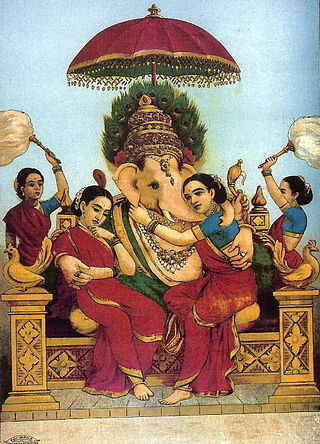
The marital status of Ganesha varies widely in mythological stories and the issue has been the subject of considerable scholarly review. Several patterns of associations with different consorts are identifiable. One pattern of myths identifies Ganesha as an unmarried brahmacārin with no consorts. Another mainstream pattern associates him with the concepts of Buddhi (intellect), Siddhi, and Riddhi (prosperity); these qualities are sometimes personified as goddesses who are considered to be Ganesha's wives. Another pattern connects Ganesha with the goddess of culture and the arts, Sarasvati. In the Bengal region he is linked with the banana tree, Kala Bo. Usually Ganesha's consort is portrayed as his shakti, a personification of his creative energy.

Ganesha, also spelled Ganesh, and also known as Ganapati, Vinayaka, and Pillaiyar, is one of the best-known and most worshipped deities in the Hindu pantheon and is the Supreme God in the Ganapatya sect. His depictions are found throughout India. Hindu denominations worship him regardless of affiliations. Devotion to Ganesha is widely diffused and extends to Jains and Buddhists and beyond India.

Varahi is one of the Matrikas, a group of seven mother goddesses in the Hindu religion. Bearing the head of a sow, Varahi is the shakti of Varaha, the boar avatar of the god Vishnu. In Nepal, she is called Barahi. In Rajasthan and Gujarat, she is venerated as Dandini.

Shri Mayureshwar Mandir or Shri Moreshwar Temple is a Hindu temple (mandir) dedicated to Ganesha, god of wisdom. It is located in Moragaon in Pune District, about 65 km away from Pune city in the Indian state of Maharashtra. The temple is the starting and ending point of a pilgrimage of eight revered Ganesha temples called Ashtavinayaka.
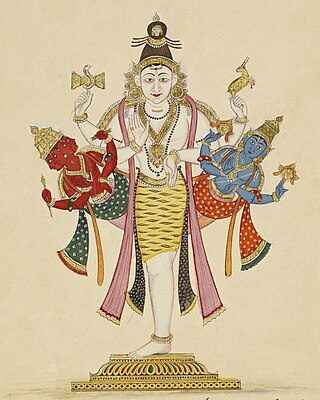
Ekapada refers to a one-footed aspect of the Hindu god Shiva. This aspect is primarily found in South India and Orissa, but also occasionally in Rajasthan and Nepal. The Ekapada is primarily represented in three iconographical forms. In the Ekapada-murti form, he is depicted as one-legged and four-armed. In the Ekapada-Trimurti form, he is depicted with the torsos of the deities Vishnu and Brahma, which together with Shiva form the Hindu Trinity (Trimurti) emanating from his sides, waist upwards and with one leg; however, sometimes, besides the central one leg of Shiva, two smaller legs of Vishnu and Brahma emerge from the sides. While some scriptures also call the latter configuration Ekapada-Trimurti, some refer it to as Tripada-Trimurti. In Orissa, where Ekapada is considered an aspect of Bhairava—the fearsome aspect of Shiva—the iconography of Ekapada-murti becomes more fierce, with motifs of blood sacrifice. This aspect is called Ekapada Bhairava.

The Siddhivinayak Temple of Siddhatek is a Hindu temple dedicated to Ganesha, the elephant-headed god of wisdom. The temple is one of the Ashtavinayaka, the eight revered shrines of Ganesha in the Indian state of Maharashtra and the only Ashtavinayaka shrine in Ahmednagar district.

Vinayaki (Vināyakī) is an elephant-headed Hindu goddess. Her mythology and iconography are not clearly defined. Little is told about her in Hindu scriptures and very few images of this deity exist.

Vaikuntha Chaturmurti or Vaikuntha Vishnu is a four-headed aspect of the Hindu god Vishnu, mostly found in Nepal and Kashmir. The icon represents Vishnu as the Supreme Being. He has a human head, a lion head, a boar head and a fierce head. Sometimes, even three-headed but aspects of Vishnu where the fierce rear head is dropped are considered to represent Vaikuntha Chaturmurti. Though iconographical treatises describe him to eight-armed, he is often depicted with four. Generally, Vaikuntha Chaturmurti is shown standing but sometimes he is depicted seated on his vahana (mount) Garuda.

Uchchhishta Ganapati is a Tantric aspect of the Hindu god Ganesha (Ganapati). He is the primary deity of the Uchchhishta Ganapatya sect, one of six major schools of the Ganapatyas. He is worshipped primarily by heterodox vamachara rituals. He is one of the thirty-two forms of Ganesha, frequently mentioned in devotional literature. Herambasuta was one of the exponents of the Uchchhishta Ganapatya sect.
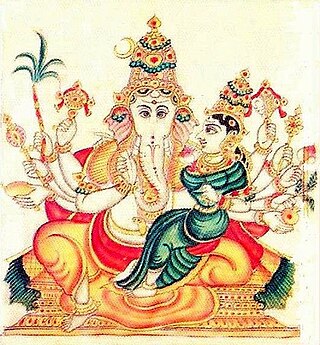
Mahaganapati, literally "Ganesha, the Great"), also spelled as Maha Ganapati, and frequently called Mahaganadhipati, is an aspect of the Hindu god Ganesha. He is the representation of Ganesha as the Supreme Being Paramatman and is the most important deity of the Ganesha-centric Ganapatya sect. He is one of the most popular of the thirty-two forms of Ganesha, worshipped as a representation of the ultimate truth Para brahman.
Thirty-two forms of Ganesha are mentioned frequently in devotional literature related to the Hindu god Ganesha (Ganapati). The Ganesha-centric scripture Mudgala Purana is the first to list them.

Bala Ganapati is an aspect of the Hindu god Ganesha (Ganapati), the elephant-headed of wisdom and fortune, depicted as a child.
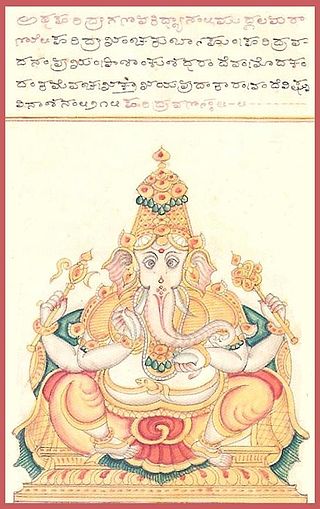
Haridra Ganapati is an aspect of the Hindu god Ganesha (Ganapati). Haridra Ganapati is also known as Ratri Ganapati. Haridra Ganapati is depicted as yellow like turmeric and wears yellow garments. He is one of the most popular thirty-two forms of Ganesha.




















